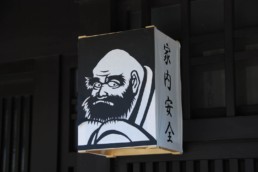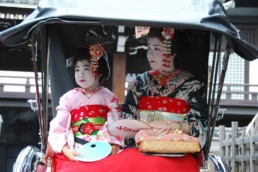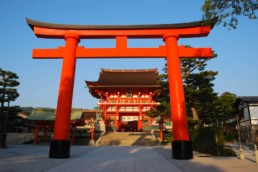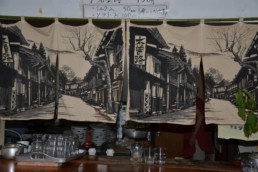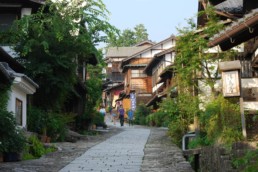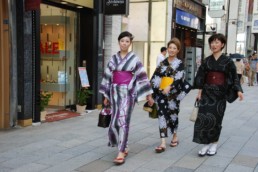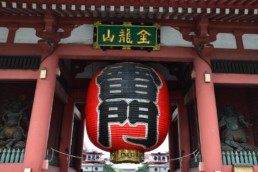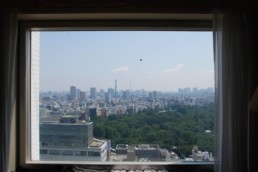The JR train ride from Kyoto to Nara takes less than one hour, and so it is convenient from Kyoto to go to Nara for a full day of sightseeing and be back in Kyoto for the evening.
In the Kyoto subway heading for the JR station, we take a moment to pay attention to the advertising banners and posters which are quite colorful and fun. There are a lot of those banners in the subway and in the trains, and quite often they are drawings inspired by the mangas style.
Nara was the capital of Japan in the 8th century, and there are still many Buddhist temples and Shinto shrines dating back to this period scattered around Nara. The most important temples and shrines are located within a huge park where a large population of deers live in total freedom.
The deers and does are worshipped in Nara. They are considered as the messengers of the Gods. They evoke the purity of ancient times when man and animal lived alongside in perfect harmony.
Before heading for the Todai-ji temple, we of course must stop and buy some food for the deers. Quickly surrounded by quite a few of these animals, the girls enjoy playing with their new friends so much, we could almost forget the purpose of our visit to Nara.
The Todai-ji temple is one of the most impressive temples in Japan. It is believed to be the largest single wooden structure in the world.
Todai-ji is the home of the Kegon sect which was introduced in Japan in 735. The temple was built with the purpose of protecting the country and bringing prosperity to the people. The large Nandaimon gate was built in 1199. The main pavilion houses a massive bronze statue of Buddha Vairocana, believed to be the largest bronze sculpture in the world.
In the afternoon, we walk to the Shinto shrine of Kasuga Taisha.
At the entrance to the sanctuary, a notice a magnificent map of the site. Still surrounded by our dear friends the deers, we also notice a scenic stack of barrels of sake.
Kasuga Taisha is the most important Shinto shrine in Nara. It is located at the top of a hill in the woods and it is a relatively long walk up the hill before reaching the sanctuary.
Kasuga Taisha is said to have been founded by the powerful Fujiwara family in the 8th century. Passed the front door, staff dressed in orange and white gowns sell tiny statues of white deers with small fortune-telling paper rolls in their mouths. We purchase one for each of our girls.
Many many lanterns hang bordering the pathways leading to the sanctuary and the walkways inside, making for a very special atmosphere.
Along with Fushimi-Inari in Kyoto, Kasuga Taisha is one of my favorite places in all of Japan. The setting of the site, the unique atmosphere, and also the silence. You are overwhelmed by how solemn and sacred the place feels. It is conducive to meditation. For a moment, you feel far and away from the agitation of the material world. This is precisely what I long for in my trips. To abandon myself, to clear my mind of all toxic thoughts, to connect with the magic of the surroundings and live the instant to its full extent. There is no better gift to me.
Fushimi-Inari and Kasuga Taisha are both located in remote places off the popular touristic pathways. They are both vermilion red, and project their special aesthetic elegance. I felt overwhelmed, yet serene, while visiting these two very unique places.
It is time to get on the JR train back to Kyoto for our last night. Tomorrow we will hit the road toward Koya-San.
























